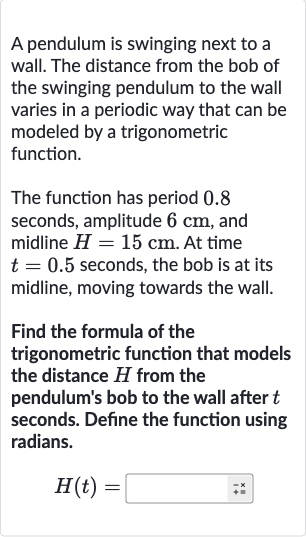AI tutor
Welcome to Bytelearn!
Let’s check out your problem:

A pendulum is swinging next to a wall. The distance from the bob of the swinging pendulum to the wall varies in a periodic way that can be modeled by a trigonometric function.The function has period . seconds, amplitude , and midline . At time seconds, the bob is at its midline, moving towards the wall.Find the formula of the trigonometric function that models the distance from the pendulum's bob to the wall after seconds. Define the function using radians.
Full solution
Q. A pendulum is swinging next to a wall. The distance from the bob of the swinging pendulum to the wall varies in a periodic way that can be modeled by a trigonometric function.The function has period . seconds, amplitude , and midline . At time seconds, the bob is at its midline, moving towards the wall.Find the formula of the trigonometric function that models the distance from the pendulum's bob to the wall after seconds. Define the function using radians.
- Determine trigonometric function: Determine the trigonometric function to use.Since the pendulum is at its midline at seconds and moving towards the wall, we can use the cosine function, which has a value of at radians (which corresponds to seconds in this context). This is because the cosine function starts at its maximum value and decreases to at , which matches the description of the pendulum's motion.
- Calculate angular frequency: Calculate the angular frequency.The period of the function is seconds. The angular frequency is related to the period by the formula . Let's calculate .\omega = \(2\pi / . = \pi / (/) = (\pi \cdot ) / = (\pi) /
- Write function with amplitude: Write the function with the amplitude and midline.The amplitude is cm, and the midline is cm. The general form of the cosine function is . Plugging in the amplitude and midline, we get:
- Adjust phase shift: Adjust the phase shift.Since the pendulum is at its midline at seconds, we need to introduce a phase shift to the function. The cosine function is at its midline when the argument of the cosine is . We need to find the phase shift such that when , the argument of the cosine function is .Let's set up the equation:
- Write final function: Write the final function.Now we include the phase shift in the function:This is the trigonometric function that models the distance from the pendulum's bob to the wall after seconds.
